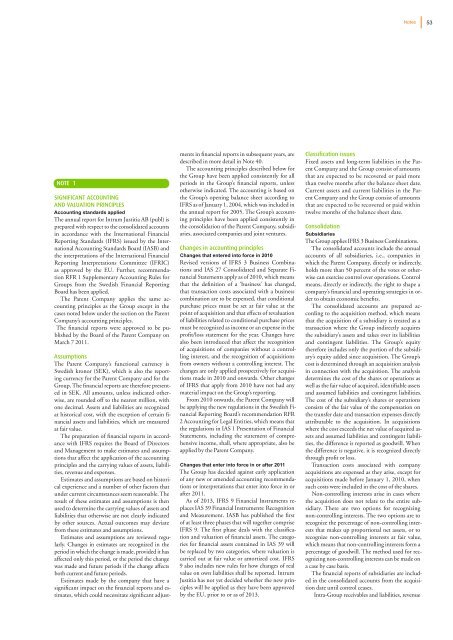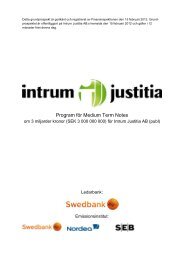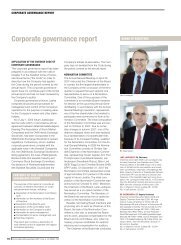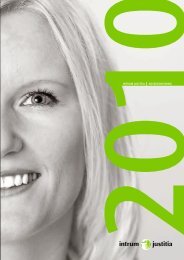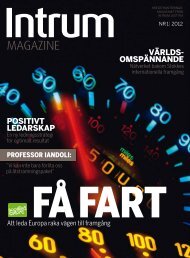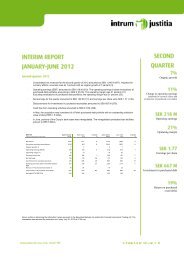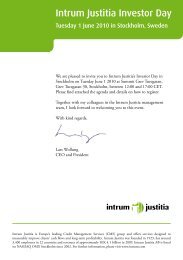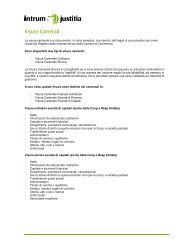ANNUAL REPORT INTRUM JUSTITIA A N N U A L R EP O R T 2 0 ...
ANNUAL REPORT INTRUM JUSTITIA A N N U A L R EP O R T 2 0 ...
ANNUAL REPORT INTRUM JUSTITIA A N N U A L R EP O R T 2 0 ...
Create successful ePaper yourself
Turn your PDF publications into a flip-book with our unique Google optimized e-Paper software.
NOTE 1<br />
SIGNIfICANT ACCOUNTING<br />
AND VALUATION PRINCIPLES<br />
Accounting standards applied<br />
The annual report for Intrum Justitia AB (publ) is<br />
prepared with respect to the consolidated accounts<br />
in accordance with the International Financial<br />
Reporting Standards (IFRS) issued by the International<br />
Accounting Standards Board (IASB) and<br />
the interpretations of the International Financial<br />
Reporting Interpretations Committee (IFRIC)<br />
as approved by the EU. Further, recommendation<br />
RFR 1 Supplementary Accounting Rules for<br />
Groups from the Swedish Financial Reporting<br />
Board has been applied.<br />
The Parent Company applies the same accounting<br />
principles as the Group except in the<br />
cases noted below under the section on the Parent<br />
Company’s accounting principles.<br />
The financial reports were approved to be published<br />
by the Board of the Parent Company on<br />
March 7 2011.<br />
Assumptions<br />
The Parent Company’s functional currency is<br />
Swedish kronor (SEK), which is also the reporting<br />
currency for the Parent Company and for the<br />
Group. The financial reports are therefore presented<br />
in SEK. All amounts, unless indicated otherwise,<br />
are rounded off to the nearest million, with<br />
one decimal. Assets and liabilities are recognized<br />
at historical cost, with the exception of certain financial<br />
assets and liabilities, which are measured<br />
at fair value.<br />
The preparation of financial reports in accordance<br />
with IFRS requires the Board of Directors<br />
and Management to make estimates and assumptions<br />
that affect the application of the accounting<br />
principles and the carrying values of assets, liabilities,<br />
revenue and expenses.<br />
Estimates and assumptions are based on historical<br />
experience and a number of other factors that<br />
under current circumstances seem reasonable. The<br />
result of these estimates and assumptions is then<br />
used to determine the carrying values of assets and<br />
liabilities that otherwise are not clearly indicated<br />
by other sources. Actual outcomes may deviate<br />
from these estimates and assumptions.<br />
Estimates and assumptions are reviewed regularly.<br />
Changes in estimates are recognized in the<br />
period in which the change is made, provided it has<br />
affected only this period, or the period the change<br />
was made and future periods if the change affects<br />
both current and future periods.<br />
Estimates made by the company that have a<br />
significant impact on the financial reports and estimates,<br />
which could necessitate significant adjust-<br />
ments in financial reports in subsequent years, are<br />
described in more detail in Note 40.<br />
The accounting principles described below for<br />
the Group have been applied consistently for all<br />
periods in the Group’s financial reports, unless<br />
otherwise indicated. The accounting is based on<br />
the Group’s opening balance sheet according to<br />
IFRS as of January 1, 2004, which was included in<br />
the annual report for 2005. The Group’s accounting<br />
principles have been applied consistently in<br />
the consolidation of the Parent Company, subsidiaries,<br />
associated companies and joint ventures.<br />
Changes in accounting principles<br />
Changes that entered into force in 2010<br />
Revised versions of IFRS 3 Business Combinations<br />
and IAS 27 Consolidated and Separate Financial<br />
Statements apply as of 2010, which means<br />
that the definition of a ‘business’ has changed,<br />
that transaction costs associated with a business<br />
combination are to be expensed, that conditional<br />
purchase prices must be set at fair value at the<br />
point of acquisition and that effects of revaluation<br />
of liabilities related to conditional purchase prices<br />
must be recognized as income or an expense in the<br />
profit/loss statement for the year. Changes have<br />
also been introduced that affect the recognition<br />
of acquisitions of companies without a controlling<br />
interest, and the recognition of acquisitions<br />
from owners without a controlling interest. The<br />
changes are only applied prospectively for acquisitions<br />
made in 2010 and onwards. Other changes<br />
of IFRS that apply from 2010 have not had any<br />
material impact on the Group’s reporting.<br />
From 2010 onwards, the Parent Company will<br />
be applying the new regulations in the Swedish Financial<br />
Reporting Board’s recommendation RFR<br />
2 Accounting for Legal Entities, which means that<br />
the regulations in IAS 1 Presentation of Financial<br />
Statements, including the statement of comprehensive<br />
income, shall, where appropriate, also be<br />
applied by the Parent Company.<br />
Changes that enter into force in or after 2011<br />
The Group has decided against early application<br />
of any new or amended accounting recommendations<br />
or interpretations that enter into force in or<br />
after 2011.<br />
As of 2013, IFRS 9 Financial Instruments replaces<br />
IAS 39 Financial Instruments: Recognition<br />
and Measurement. IASB has published the first<br />
of at least three phases that will together comprise<br />
IFRS 9. The first phase deals with the classification<br />
and valuation of financial assets. The categories<br />
for financial assets contained in IAS 39 will<br />
be replaced by two categories, where valuation is<br />
carried out at fair value or amortized cost. IFRS<br />
9 also includes new rules for how changes of real<br />
value on own liabilities shall be reported. Intrum<br />
Justitia has not yet decided whether the new principles<br />
will be applied as they have been approved<br />
by the EU, prior to or as of 2013.<br />
Notes<br />
Classification issues<br />
Fixed assets and long-term liabilities in the Parent<br />
Company and the Group consist of amounts<br />
that are expected to be recovered or paid more<br />
than twelve months after the balance sheet date.<br />
Current assets and current liabilities in the Parent<br />
Company and the Group consist of amounts<br />
that are expected to be recovered or paid within<br />
twelve months of the balance sheet date.<br />
Consolidation<br />
Subsidiaries<br />
The Group applies IFRS 3 Business Combinations.<br />
The consolidated accounts include the annual<br />
accounts of all subsidiaries, i.e., companies in<br />
which the Parent Company, directly or indirectly,<br />
holds more than 50 percent of the votes or otherwise<br />
can exercise control over operations. Control<br />
means, directly or indirectly, the right to shape a<br />
company’s financial and operating strategies in order<br />
to obtain economic benefits.<br />
The consolidated accounts are prepared according<br />
to the acquisition method, which means<br />
that the acquisition of a subsidiary is treated as a<br />
transaction where the Group indirectly acquires<br />
the subsidiary’s assets and takes over its liabilities<br />
and contingent liabilities. The Group’s equity<br />
therefore includes only the portion of the subsidiary’s<br />
equity added since acquisition. The Group’s<br />
cost is determined through an acquisition analysis<br />
in connection with the acquisition. The analysis<br />
determines the cost of the shares or operations as<br />
well as the fair value of acquired, identifiable assets<br />
and assumed liabilities and contingent liabilities.<br />
The cost of the subsidiary’s shares or operations<br />
consists of the fair value of the compensation on<br />
the transfer date and transaction expenses directly<br />
attributable to the acquisition. In acquisitions<br />
where the cost exceeds the net value of acquired assets<br />
and assumed liabilities and contingent liabilities,<br />
the difference is reported as goodwill. When<br />
the difference is negative, it is recognized directly<br />
through profit or loss.<br />
Transaction costs associated with company<br />
acquisitions are expensed as they arise, except for<br />
acquisitions made before January 1, 2010, when<br />
such costs were included in the cost of the shares.<br />
Non-controlling interests arise in cases where<br />
the acquisition does not relate to the entire subsidiary.<br />
There are two options for recognizing<br />
non-controlling interests. The two options are to<br />
recognize the percentage of non-controlling interests<br />
that makes up proportional net assets, or to<br />
recognize non-controlling interests at fair value,<br />
which means that non-controlling interests form a<br />
percentage of goodwill. The method used for recognizing<br />
non-controlling interests can be made on<br />
a case by case basis.<br />
The financial reports of subsidiaries are included<br />
in the consolidated accounts from the acquisition<br />
date until control ceases.<br />
Intra-Group receivables and liabilities, revenue<br />
53


